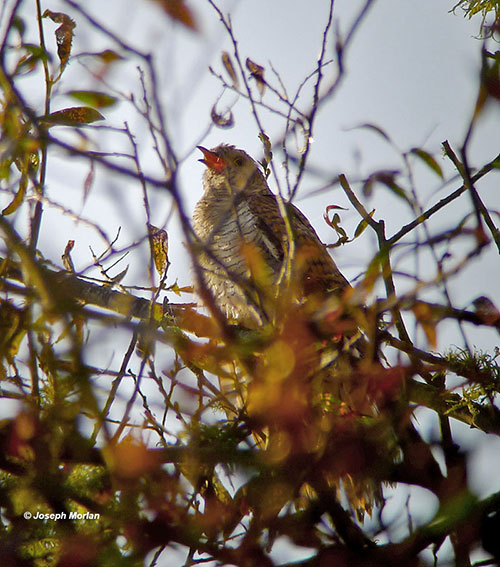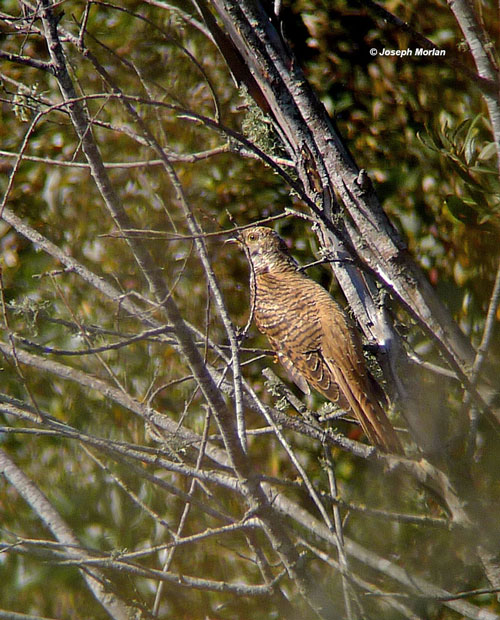Common Cuckoo (Cuculus canorus)
Ramsay Park, Watsonville, Santa Cruz County CA
30 September 2012
Joseph Morlan
Photos © 30 September 2012 by Joseph Morlan. All rights reserved (Higher resolution images).
 This unexpected and extraordinary vagrant was reported during the Western Field Ornithologists
annual conference in Petaluma. It was found Friday, 28 September 2012 by Lois Goldfrank and Steve Gerow. On Sunday,
I arrived at the nature center about 7:30am and there were already lots of birders and photographers on site. The
previous night, the cuckoo had been seen going to roost in willows between the soccer field and Watsonville Slough.
John Sorenson first located the bird and Al Demartini helped point it out. The bird was sitting in the middle of
dense willows against the sun, so the lighting could not have been worse.
This unexpected and extraordinary vagrant was reported during the Western Field Ornithologists
annual conference in Petaluma. It was found Friday, 28 September 2012 by Lois Goldfrank and Steve Gerow. On Sunday,
I arrived at the nature center about 7:30am and there were already lots of birders and photographers on site. The
previous night, the cuckoo had been seen going to roost in willows between the soccer field and Watsonville Slough.
John Sorenson first located the bird and Al Demartini helped point it out. The bird was sitting in the middle of
dense willows against the sun, so the lighting could not have been worse.
Eventually we got a better angle and we started to see some plumage features. I was able to begin photographing
the bird (upper right). These photos are digiscoped through a Nikon Fieldscope III. The bird moved to the north
end of the willows where we obtained an unobstructed view for a while and the lighting was much better. The bird
disappeared for several hours but was relocated behind the nature center. It soon flew under the bridge to an open
location on the south side where a large group got good views. My last photo below was taken here and it shows
the rump pattern well.
Description
The following description is based on memory and on photos:
A large cuckoo, with robust body, small head and long tail, heavily barred all over. I judged the bird to
be somewhat larger than a Western Scrub-Jay, but I never had direct size comparison.
The bill was short and slightly curved coming to a hook at the tip. The base of the bill was yellowish, especially
on the lower mandible, but the tip of the bill and culmen were blackish. The mouth lining appeared to be pinkish
(see photo to right). The iris was dark honey colored with an obvious yellow orbital ring. I believe this was bare
skin and not feathers. The yellow feet were occasionally visible with two toes pointing forward and two back.
The head and the entire upperparts were brown with extensive black cross-bars often with white highlights.
An obvious white smudge was evident on the nape. The neck feathers were heavily barred and often raised forming
an apparent ruff. The lower back, rump and uppertail coverts were a brighter tawny rufous color and quite plain
except for black and white subterminal markings to the  tips of some of the individual feathers. The underparts were
grayish white with extensive narrow dark brown barring across the throat, breast and belly. However, the lower
belly and undertail coverts appeared to be unmarked. The tail was long and graduated, rusty above with black and
white bars laterally, more evident on the underside of the tail (outer rectrices).
tips of some of the individual feathers. The underparts were
grayish white with extensive narrow dark brown barring across the throat, breast and belly. However, the lower
belly and undertail coverts appeared to be unmarked. The tail was long and graduated, rusty above with black and
white bars laterally, more evident on the underside of the tail (outer rectrices).
In flight the wings appeared to be strongly pointed, giving the bird a falcon-like shape. However, the flight
style was very floppy and unfalcon-like. No vocalizations were heard.
The bird foraged exclusively on yellow and black caterpillars of the Yellow-spotted Tiger Moth aka Spotted
Tussock Moth (Lophocampa maculata).
Discussion
Age and sex
The white nape patch, extensive white highlights to the the dorsal barring, and whitish tips to the primaries
with small subterminal dark spots indicate that this bird is in juvenal plumage. In this plumage, there is no apparent
sex-linkage with color morph. It was pointed out by Peter Adriaens that some some scapular feathers have already
been molted and are adult-like. These are darker brown and lack the white highlights adjacent to the dark bars.
However, it is uncertain at this time if formative plumage color morphs are sex-linked as adults. In adults, the
hepatic morph is known to be confined to females .
Species
This bird is clearly a Cuculus but the identification of juveniles is complicated. Most observers believe
the bird is a Common Cuckoo (C. canorus) and that is likely the case. The main feature supporting Common
Cuckoo vs. Oriental Cuckoo (C. saturatus) is the largely unmarked rump. In juvenal plumage both species
can have heavily barred rumps, but preliminary research indicates that only Common Cuckoo can have an unbarred
rump.
Further discussion has centered on the overall size (larger in Common), shape (relatively smaller head and bill
in Common), tail length (relatively longer in Common), tail pattern (less contrasting on Oriental), ventral barring
(less barring on Common), underwing (less contrasting in Common), and alula (barred only in Common). Additional
characters such as the strength of barring on the underparts may also support Common vs. Oriental Cuckoo, but expert
opinion warns that all these proposed characters are subjective or unreliable in juvenal plumage. Further research
is needed.
Addendum - 11 October 2012
Expert opinion seems to favor this bird being a Common Cuckoo and I will submit it as such. An annotated copy
of David Irons's photo by Peter Adriaens showing molt and comparison with adult hepatic morph Common Cuckoo is
here.
Outside Links
There is an article by Paul Baicich on page 68 of the July 2010 issue of Birding about the Martha's Vineyard
Common Cuckoo. The bird was found on 3 May 1981, captured in a mistnet and banded the next day, and not seen again.
Paul also mentions a November 1958 record from Barbados.
 This unexpected and extraordinary vagrant was reported during the Western Field Ornithologists
annual conference in Petaluma. It was found Friday, 28 September 2012 by Lois Goldfrank and Steve Gerow. On Sunday,
I arrived at the nature center about 7:30am and there were already lots of birders and photographers on site. The
previous night, the cuckoo had been seen going to roost in willows between the soccer field and Watsonville Slough.
John Sorenson first located the bird and Al Demartini helped point it out. The bird was sitting in the middle of
dense willows against the sun, so the lighting could not have been worse.
This unexpected and extraordinary vagrant was reported during the Western Field Ornithologists
annual conference in Petaluma. It was found Friday, 28 September 2012 by Lois Goldfrank and Steve Gerow. On Sunday,
I arrived at the nature center about 7:30am and there were already lots of birders and photographers on site. The
previous night, the cuckoo had been seen going to roost in willows between the soccer field and Watsonville Slough.
John Sorenson first located the bird and Al Demartini helped point it out. The bird was sitting in the middle of
dense willows against the sun, so the lighting could not have been worse. tips of some of the individual feathers. The underparts were
grayish white with extensive narrow dark brown barring across the throat, breast and belly. However, the lower
belly and undertail coverts appeared to be unmarked. The tail was long and graduated, rusty above with black and
white bars laterally, more evident on the underside of the tail (outer rectrices).
tips of some of the individual feathers. The underparts were
grayish white with extensive narrow dark brown barring across the throat, breast and belly. However, the lower
belly and undertail coverts appeared to be unmarked. The tail was long and graduated, rusty above with black and
white bars laterally, more evident on the underside of the tail (outer rectrices).